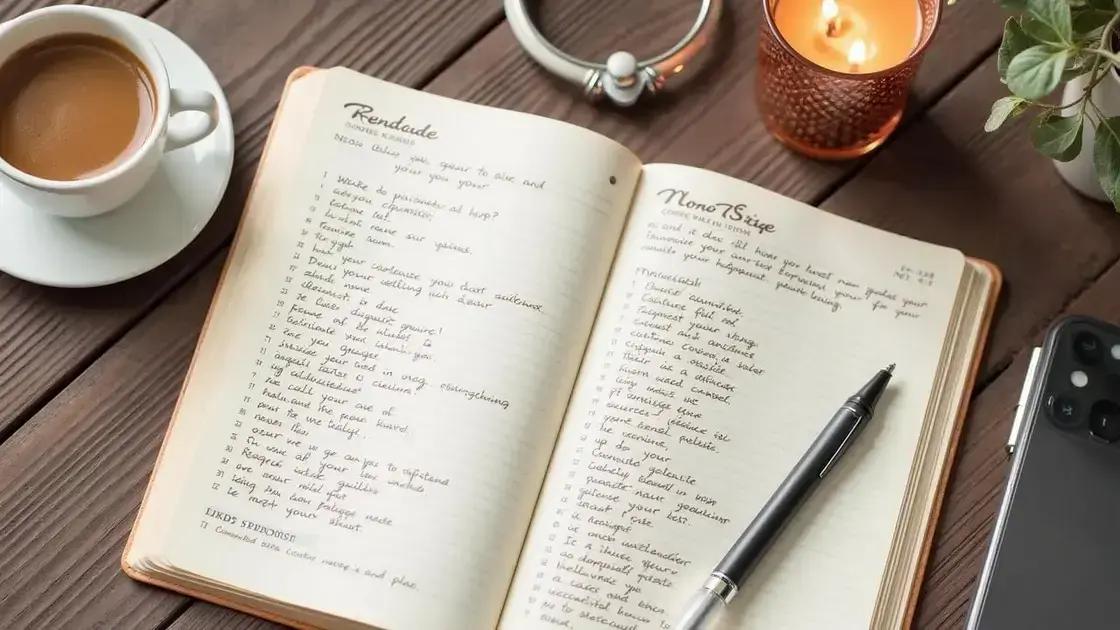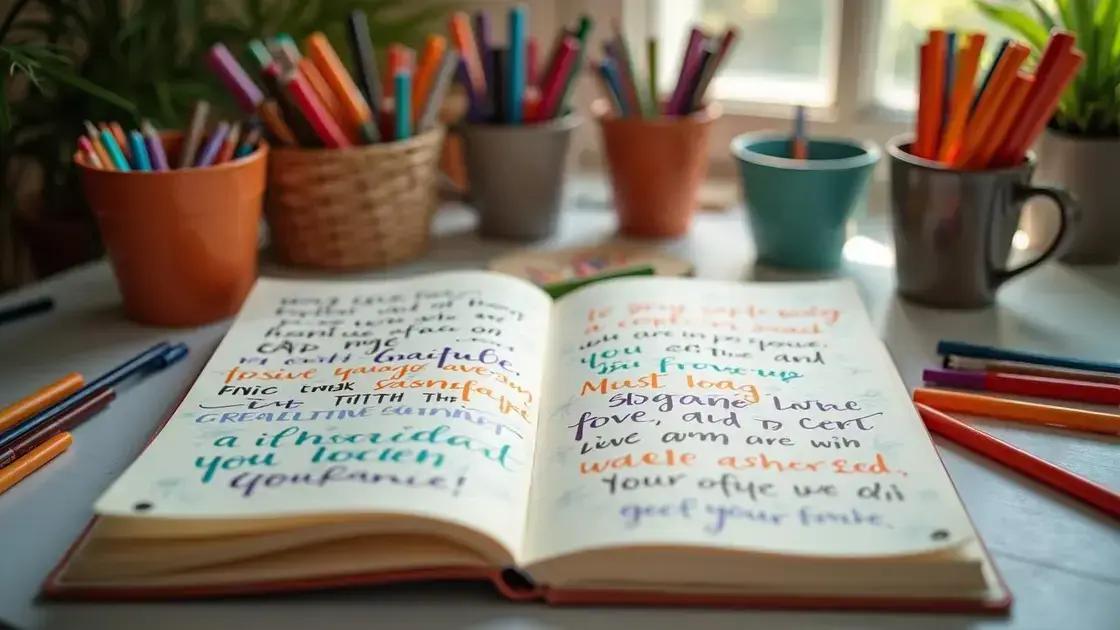The role of daily gratitude journaling in mental wellbeing is significant as it helps improve mood, reduce stress, and enhance emotional stability by encouraging individuals to focus on positive aspects of their lives. By regularly reflecting on what they are thankful for, users can foster a more optimistic outlook and improve their overall quality of life.
Daily gratitude journaling is a powerful tool for improving mental wellbeing. By regularly reflecting on what we are thankful for, we cultivate positivity and resilience in our lives. This article will delve into the role of gratitude journals and provide practical tips on how to incorporate this simple yet effective practice into your daily routine.
Understanding Gratitude Journaling

Gratitude journaling is the practice of writing down things you are grateful for. This simple exercise can have a significant impact on your mental wellbeing. By focusing on the positive aspects of your life, you train your mind to think more optimistically. Understanding gratitude journaling involves recognizing its purpose and how it can be integrated into your daily routine.
Every entry in a gratitude journal helps create a positive mindset. Writing down what you’re thankful for can take just a few minutes each day. It can be anything from a person’s kindness to a beautiful sunset. Being specific about what you appreciate enhances the effectiveness of this practice.
Why Gratitude Journaling Matters
At its core, gratitude journaling shifts your focus. Instead of dwelling on negative thoughts, you look for the silver linings in daily life. This shift can lead to improved mental health, less stress, and a greater sense of happiness. Studies show that regularly practicing gratitude can lead to greater life satisfaction and even better physical health.
The Process of Journaling
Begin by choosing a medium for your gratitude journal. This could be a classic notebook, a digital document, or an app designed for journaling. The most important part is to remain consistent. Set aside time each day, even if it’s just five minutes, to jot down your thoughts.
You can use prompts if you struggle to find things to write about. Some examples include “What made me smile today?” or “Who am I grateful for this week?” By consistently focusing on gratitude, you can create a habit that enhances your overall mental wellbeing.
Benefits of Daily Gratitude Practice

Practicing gratitude on a daily basis offers numerous benefits for your mental wellbeing. By reflecting on what you are thankful for, you begin to enhance your overall mood. Daily gratitude practice helps shift your focus from what is lacking in your life to what you already have.
One significant benefit of gratitude is its ability to reduce feelings of stress and anxiety. When you focus on positive aspects of your life, it becomes harder to dwell on negative thoughts. This shift can foster a greater sense of peace and emotional stability.
Improved Relationships
Another advantage of daily gratitude practice is the improvement of relationships. Expressing gratitude towards others can strengthen bonds and create a sense of connection. A simple “thank you” can go a long way in making those around you feel appreciated.
Boosts Self-Esteem
Gratitude can also lead to higher self-esteem. When you recognize the positive things in your life, you cultivate a more fulfilling perspective. This can improve confidence and help you approach challenges with a positive attitude.
Better Sleep Quality
Practicing gratitude before bed can enhance your sleep quality. Writing down what you are grateful for can calm your mind and reduce negative thoughts that may keep you awake. Better sleep leads to improved overall health and mental clarity.
Daily gratitude practice is not just a trend; it is a way to promote mental wellbeing. By integrating gratitude into your daily routine, you can experience these benefits and improve your quality of life.
How to Start Your Gratitude Journal

Starting your gratitude journal is easier than you might think. Follow these simple steps to make gratitude journaling a part of your daily routine. Begin with selecting a medium that works for you. This could be a classic notebook, an online app, or even a simple word document.
Next, find a consistent time in your day to write. Many people prefer morning or evening time. The goal is to create a habit that keeps you accountable. Set aside about 5 to 10 minutes to jot down your thoughts.
What to Write
When writing in your gratitude journal, think about the specific things you appreciate. You can write about three things you’re grateful for each day. These can be big or small, like a supportive friend or a delicious meal. Be detailed in your entries to make them more meaningful. Instead of writing “I’m grateful for my friend,” say “I’m grateful for my friend who spent time with me when I felt sad.” This adds depth to your writing.
Use Prompts
If you ever feel stuck, using prompts can help. Examples include “What made me smile today?” or “What did I learn today?” These can guide your thoughts and provide inspiration when you’re unsure about what to write. Consistency is key, so try to stick with your practice.
Reflect on Your Gratitude
Over time, take a moment to revisit past entries. Reflecting on what you wrote can help deepen your understanding of your own growth and happiness. You will notice positive patterns and reflections as you practice gratitude regularly.
Remember, there is no right or wrong way to keep a gratitude journal. The important part is finding what works best for you and making it a regular habit.
Tips for Effective Journaling

To maximize the benefits of gratitude journaling, consider these tips for effective journaling. First, always keep your journal accessible. If it’s easy to reach, you’re more likely to write regularly. You can place it on your nightstand or carry a small journal with you.
Another tip is to make your journaling practice enjoyable. Choose a writing style that feels natural to you. You might want to use colorful pens, stickers, or even sketches to express your thoughts. This can make the process feel less like a chore and more like a creative outlet.
Be Consistent
Try to write daily, but if that feels overwhelming, aim for a few times a week. Consistency helps form a habit. Setting a specific time for journaling can also help. Whether it’s in the morning or before bed, find a time that works best for you.
Focus on Feelings
When you write, focus on how you feel about the things you are grateful for. Instead of just listing items, write about why they matter to you. This deeper reflection enhances the emotional impact of your gratitude practice and fosters a stronger sense of appreciation.
Mix It Up
Don’t hesitate to change your approach. If you notice your enthusiasm waning, try different prompts or themes. For example, you could focus on things that made you laugh, moments that brought you joy, or lessons learned during tough times. Variety keeps the practice fresh and engaging.
Reading your entries back over time can also be very uplifting. Looking back at your past entries can remind you of how far you’ve come and the good things in your life. This reflection reinforces the positive mindset that gratitude journaling seeks to cultivate.
Embracing Daily Gratitude Journaling for Mental Wellbeing
Daily gratitude journaling can have a profound impact on your mental wellbeing. By taking the time to reflect on the positive aspects of life, you foster a mindset that appreciates what you have rather than focusing on what you lack.
Through understanding the process, exploring the benefits, and learning effective journaling techniques, you can turn gratitude into a meaningful practice. This not only enhances your mental health but can also improve your relationships, boost self-esteem, and promote emotional stability.
As you embark on or continue your gratitude journaling journey, remember that consistency and personalization are key. Make it enjoyable, and don’t hesitate to adjust your approach as needed. By prioritizing gratitude in your life, you are making a powerful choice for your overall happiness and wellbeing.
FAQ – Frequently Asked Questions about Daily Gratitude Journaling
What is a gratitude journal?
A gratitude journal is a personal diary where you write down things you are thankful for to enhance your mental wellbeing.
How often should I write in my gratitude journal?
To gain the most benefit, try to write daily. However, writing a few times a week can also be effective if daily feels overwhelming.
Can gratitude journaling really improve my mental health?
Yes, numerous studies have shown that practicing gratitude can lead to reduced stress, increased happiness, and improved emotional stability.
What should I write about in my gratitude journal?
You can write about anything that makes you feel grateful, from personal achievements to simple pleasures like a nice meal or a kind word from a friend.
Do I need to write long entries?
No, entries can be as simple or detailed as you like. Even a single sentence expressing gratitude can be powerful.
How can I stay consistent with journaling?
Choose a specific time each day to write, keep your journal easily accessible, and find ways to make the process enjoyable.












